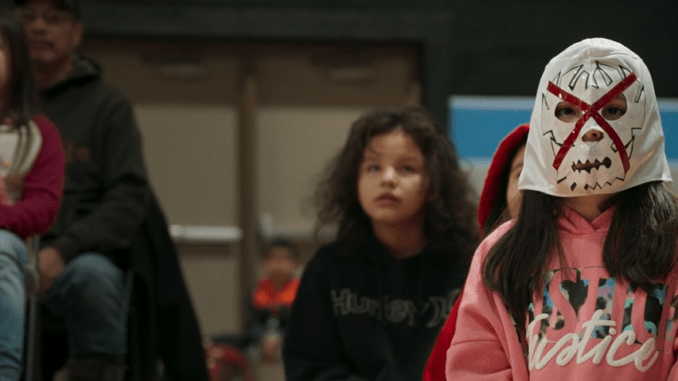
Professional wrestling is a brutal business and one that is notoriously hard to make money in at every level. When considering this, it might be hard to understand why thousands of people across the world insist on consuming long-term damage to their heads, necks, backs, and every other part of their body to perform in the ring.
The new Canadian documentary “The Death Tour” provides a thoughtful glimpse into a few examples of what inspires some wrestlers to give themselves to an often unforgiving form of entertainment.
The film, which is directed by Stephan Peterson and co-directed by Sonya Ballantyne, follows wrestlers as they partake in a legendary Canadian tour that has previously included wrestling figures like Chris Jericho, Kenny Omega, Edge, Lance Storm, and others. The documentary debuted earlier this year and is set to air in select Canadian theaters this summer.
“The Death Tour” is a classic case getting viewers in the door with one topic, then making them stay with an even more gripping story.
The movie markets itself with a premise that would entice wrestling fans more than others: Wanna-be wrestling stars embark on a gruelling two-week trip through Northern Mantioba’s frigid winter temperatures to prove they can make it in the industry. They must survive early mornings and long nights, lengthy road trips, and lots of wrestling.
But the rigid sink-or-swim way of looking at the tour becomes almost a sidenote by the end. It becomes clear throughout the film that the wrestlers involved have different motivations, many of which reject the traditional idea of what it means to “make it” in the industry. They aren’t wrestling to be the next big WWE or AEW star, nor are they dreaming of the big contracts that could buy them a new house. They are fighting their own personal battles, all unique and compelling in their own ways.
The most important story that the movie tells is how wrestling can drive change, and why that pushed some of the film’s subjects to get involved. As the crew travels through Indigenous reserves across the ice-cold terrain, they touch on communities that struggle with isolation. As the areas battle suicide and substance abuse due to the harsh realities of geographic isolation, wrestling is a way for youth in the area to escape, even if just for a moment.
The movie is full of long shots that best portray the childlike wonder that wrestling can provide. Kids are seen standing on their seats to cheer for “McKenrose the Scottish Warrior,” who they genuinely believe is from Scotland instead of Quebec. They are providing a double thumbs-down and booing loudly to “Massive Damage,” or whoever was set up to be a heel that night. They’re wondering innocent questions that keep kayfabe alive, like asking off-the-clock wrestlers if they still hate each other.
It’s the small, subtle moments like those that show how wrestling can transport people to a different world, taking them out of whatever day-to-day problems they might be facing. It’s just one of the many ways that positive change is shown in the movie.
The story of persisting in the face of colonialism and using wrestling as an outlet for positivity is best shown when the movie focuses on Indigenous talents Sage “The Matriarch” Morin and Dez “The Eskimofo” Loreen. The individual struggles that Morin, a Saddle Lake Cree Nation woman, and Loreen, an Inuk man, have faced brought them to wrestling and inevitably put them on the gruelling tour.
While the film follows four main figures it is Morin who steals the show. Her story is one of significant perseverance, being a strong mother for her son after the tragic loss of her other child due to an intoxicated driver. She provides an inspiring connection with youth during her trip across the country, motivated by the opportunity to inspire others with the image of a strong Indigenous woman performing in the ring. It is her story that best shows how wrestling can provide an important outlet to fans and performers alike.
The skills of Peterson and Ballantyne to accurately and coherently tell numerous moving stories at once were on display in “The Death Tour.” The movie effortlessly flows in and out of different narratives without ever becoming hard to follow. Also shown is Sarah McNicoll, a French-Canadian woman who found direction in life with wrestling after struggling with depression. Sean Dunster provides the most stereotypical look of a pro wrestler, providing a hard exterior and speaking of the laundry list of injuries he has been through. He tells the intriguing story of someone who is in the twilight years of his career but is determined to chase the high of performing, even if that means playing to small crowds and traveling long distances to do so.
Wrestling’s top names are undoubtedly larger-than-life characters. However, in “The Death Tour,” none of the wrestlers involved provide such aura. There are so many ways that they are shown as just like us: McNicoll provides a quiet demeanor and is a veterinarian by day, Loreen is an at-times awkward, nerdy figure whose house is plastered with memorabilia celebrating wrestling.
“The Death Tour” isn’t about the wrestlers grinding their way to the top and paying their dues to find fame and riches later in their careers. It’s about everyday people who have found a purpose through their performances, helping their battles while touching many other lives in the process.
Wrestling is an industry that is known for taking. Anyone involved can speak about the injuries and even passings for which it can be held responsible. “The Death Tour” gives a few of the endless explanations as to why the art form continues to exist despite that.
For information on screenings of ‘The Death Tour” across Canada, visit https://www.deathtourdoc.com/
